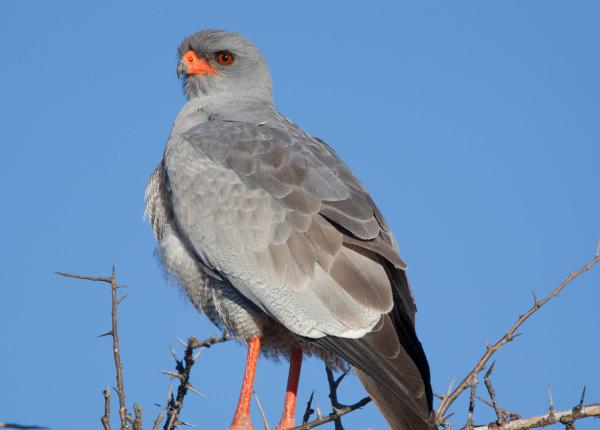Did You Know?
- There are two recognized subspecies of the Pale Chanting-goshawk
- The Pale Chanting-goshawk prefers drier habitat than the Dark Chanting-goshawk
- This raptor has been documented hunting some surprising prey including a Spotted Eagle-owl and a Common Kestrel!
- This species is known to follow other small predators, such as honey badgers and mongoose, in the hopes they will flush out prey that the goshawk can then catch.
How The Peregrine Fund is Helping
Though The Peregrine Fund doesn't work directly with Pale Chanting-goshawks, in Kenya, our scientists are working hard to learn about and protect all raptors and their habitats. Through environmental education efforts, we are also working to put a stop to the common practice of poisoning carcasses to kill large predators, which also kills a host of wildlife including vultures, eagles, and other scavenging birds. These efforts will certainly benefit all raptors of the region, including the Pale Chanting-goshawk.
Meanwhile, our efforts in scientific research, habitat conservation, education, and community development help conserve birds of prey around the world. We also supply literature to researchers from our avian research library, which helps scientists around the world gather and share important information on raptor conservation. We also run the Global Raptor Impact Network which gives raptor researchers tools to more efficiently conduct their own studies while contributing to a global program. GRIN also provides citizen scientists a way to participate in raptor science and conservation.
Where They Live
The lovely, Pale Chanting-goshawk is found throughout much of southern Africa. It tends to avoid dense forests, but instead prefers to spend its time in open savanna and other dry habitats, especially areas with limited ground cover, scattered trees and bushes, and along streams.
What They Do
If you ever find yourself in Pale Chanting-goshawk habitat, be sure to scan nearby telephone poles or bushes, as these are some of this goshawk's favorite perching spots. They also spend time on the ground. Though this raptor is normally found alone or in pairs, it does occasionally hang out in family groups of five individuals or more!
Why They Need our Help
This gorgeous bird of prey is categorized as a species of Least Concern. It is generally common and widespread throughout its range. However, this doesn't mean that this species isn't facing some important threats. Their prey can become contaminated when pesticides are sprayed during locust plagues, they suffer collisions with power lines, and people shoot them because they sometimes prey on domestic fowl. Sometimes, these birds even drown in farm reservoirs.
What They Eat
This bird of prey has a long list of prey on its menu! It feeds on snakes, lizard and insects, including dung-beetles and grasshoppers. But it will also hunt birds, even some surprisingly large ones. It will also take advantage of road kill and other carrion to scavenge. When on the hunt, it engages in a few different hunting techniques. It might dive down, fly quickly through the air or run along the ground, in pursuit of prey, A lot of the time, it sits on a well-exposed perch, waiting and watching for unsuspecting prey. When it spots something it would like to eat, it glides down to snatch prey from the ground, sometimes completing the chase on foot. It might even walk around on the ground in search of prey or fly low over an open area, like a harrier, in search of a good meal.
Nests, Eggs, and Young
Like many raptor species, Pale Chanting-goshawks build their nests out of sticks. Both the male and female work together to construct the nest, which they line with some interesting materials including rags, wool, and even dung! They build the nest in the upper fork of a thorny tree or on a utility pole. The nest is occasionally re-used during subsequent seasons, though pairs often build a new nest each breeding season. When the time is right, the female will lay up to two eggs and she will be almost entirely responsible for incubating the eggs for the following 37 days.
After the nestlings hatch, they will grow quickly, though generally only one chick survives to the end of the nestling period, which lasts about eight weeks. This is because the nestlings engage in siblicide - when one chick (usually the larger, older one) kills the other. The young will stay in the nest for 44–56 days growing strong, before it is ready to make its first flight.
Though not very common, researchers have observed this species engaging in polyandry - where one female and two males engage in breeding behavior, raising young together.
Pale Chanting-goshawk and the World Center for Birds of Prey
The World Center for Birds of Prey offers fun ways to learn about birds of prey. Interactive activities, tours, interesting videos and a children's room with activities from coloring sheets to quizzes to costumes are all available for our guests. We also have knowledgeable, on-site staff to answer any questions you may have. Though we don't have any goshawks on our Avian Ambassador team, the Northern Goshawk can be found in Idaho year-round. They nest in large trees within the Sawtooth National Forest located only a few hours away from The Peregrine Fund's World Center for Birds of Prey.
References:
Global Raptor Information Network. 2022. Species account: Pale Chanting Goshawk Melierax canorus. Downloaded from http://www.globalraptors.org on 5 Nov. 2022
Kemp, A. C. and G. M. Kirwan (2020). Pale Chanting-Goshawk (Melierax canorus), version 1.0. In Birds of the World (J. del Hoyo, A. Elliott, J. Sargatal, D. A. Christie, and E. de Juana, Editors). Cornell Lab of Ornithology, Ithaca, NY, USA. https://doi.org/10.2173/bow.pacgos1.01









